Ethics, Sustainability and Social Impact - Desklib
VerifiedAdded on 2023/06/14
|9
|2580
|211
AI Summary
This article discusses the impact of ethics, sustainability and social issues on information technology and society. It covers the need for a new field of AI to combat racial bias, issues with AI and gender and racial bias, and the digital gender gap in low- and middle-income countries. Recommendations are provided to address these issues.
Contribute Materials
Your contribution can guide someone’s learning journey. Share your
documents today.
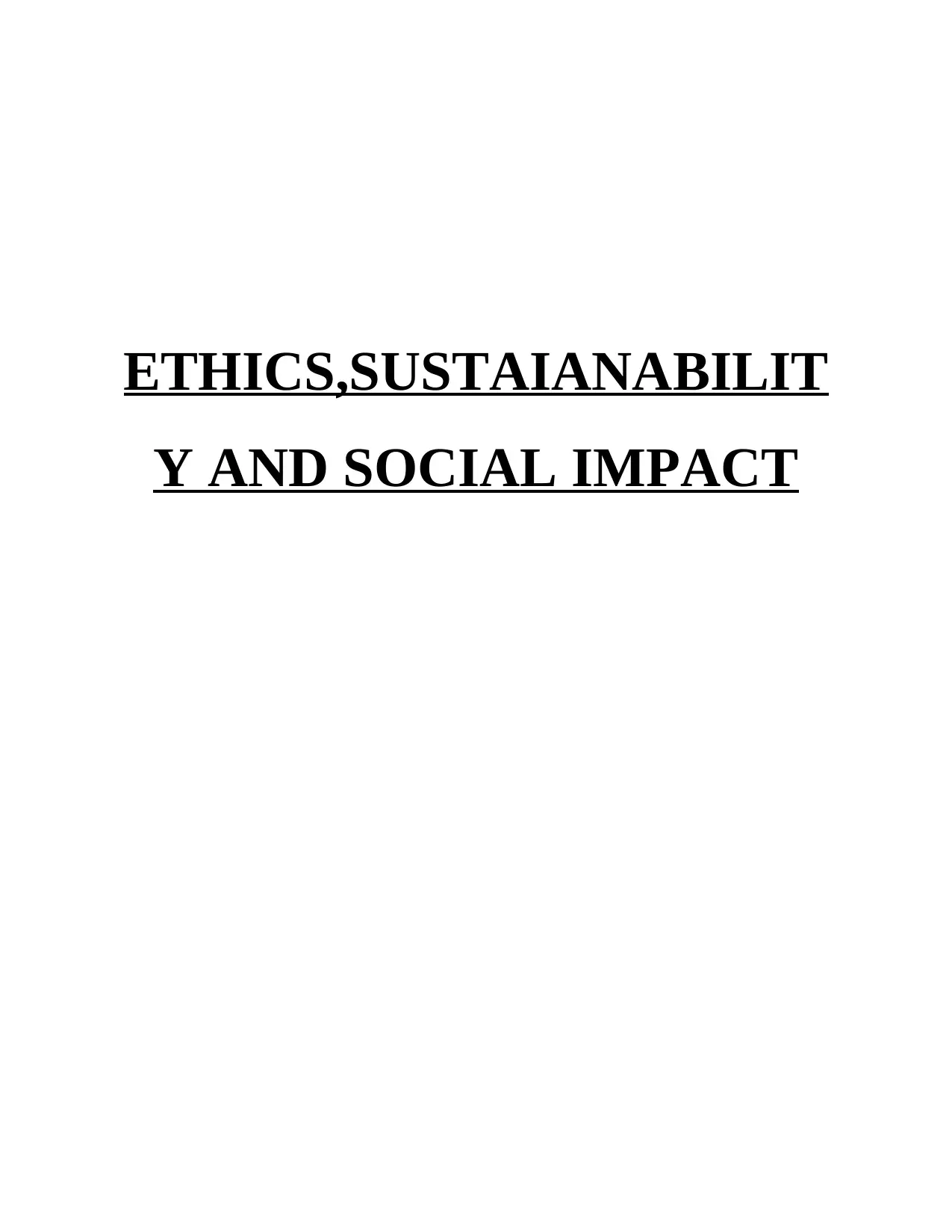
ETHICS,SUSTAIANABILIT
Y AND SOCIAL IMPACT
Y AND SOCIAL IMPACT
Secure Best Marks with AI Grader
Need help grading? Try our AI Grader for instant feedback on your assignments.
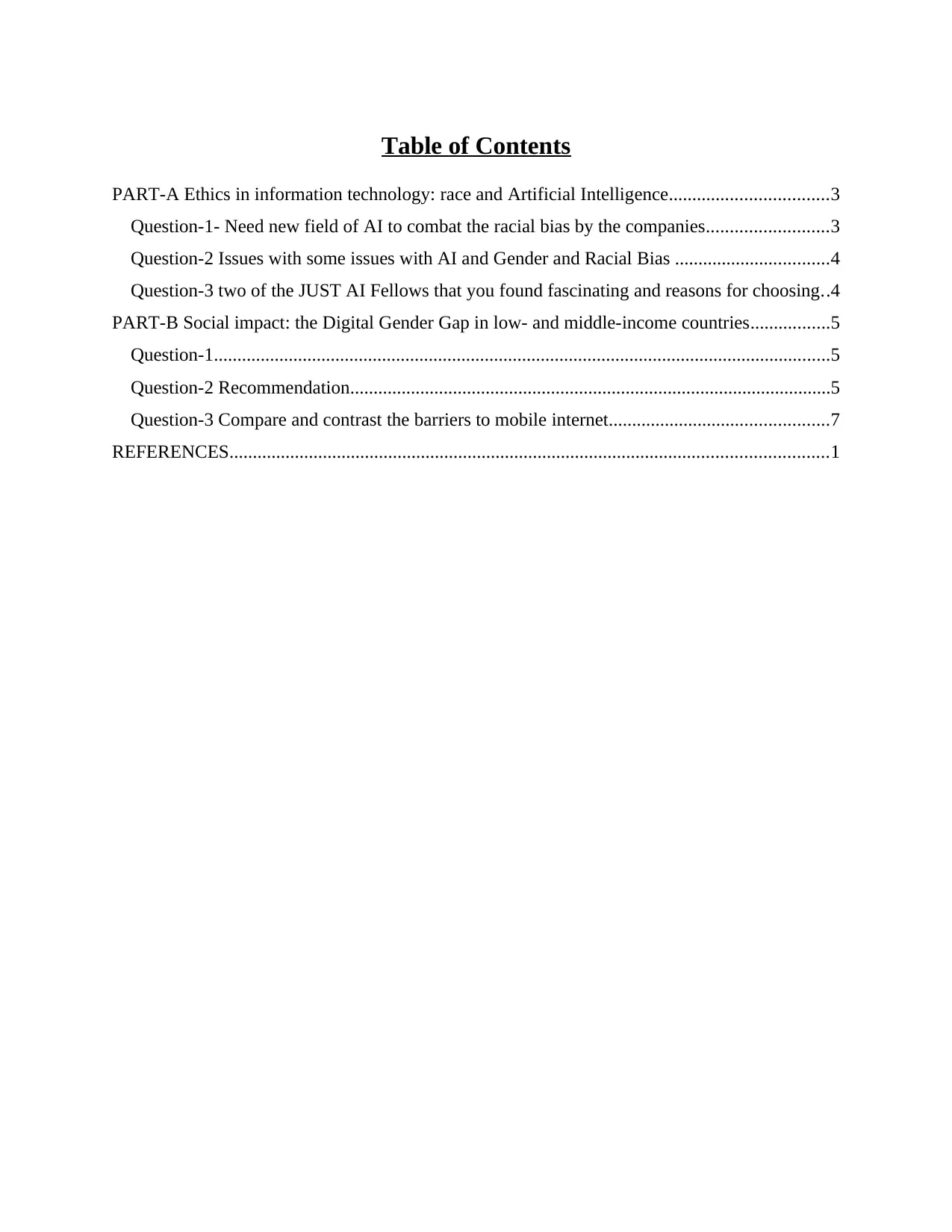
Table of Contents
PART-A Ethics in information technology: race and Artificial Intelligence..................................3
Question-1- Need new field of AI to combat the racial bias by the companies..........................3
Question-2 Issues with some issues with AI and Gender and Racial Bias .................................4
Question-3 two of the JUST AI Fellows that you found fascinating and reasons for choosing..4
PART-B Social impact: the Digital Gender Gap in low- and middle-income countries.................5
Question-1....................................................................................................................................5
Question-2 Recommendation.......................................................................................................5
Question-3 Compare and contrast the barriers to mobile internet...............................................7
REFERENCES................................................................................................................................1
PART-A Ethics in information technology: race and Artificial Intelligence..................................3
Question-1- Need new field of AI to combat the racial bias by the companies..........................3
Question-2 Issues with some issues with AI and Gender and Racial Bias .................................4
Question-3 two of the JUST AI Fellows that you found fascinating and reasons for choosing..4
PART-B Social impact: the Digital Gender Gap in low- and middle-income countries.................5
Question-1....................................................................................................................................5
Question-2 Recommendation.......................................................................................................5
Question-3 Compare and contrast the barriers to mobile internet...............................................7
REFERENCES................................................................................................................................1
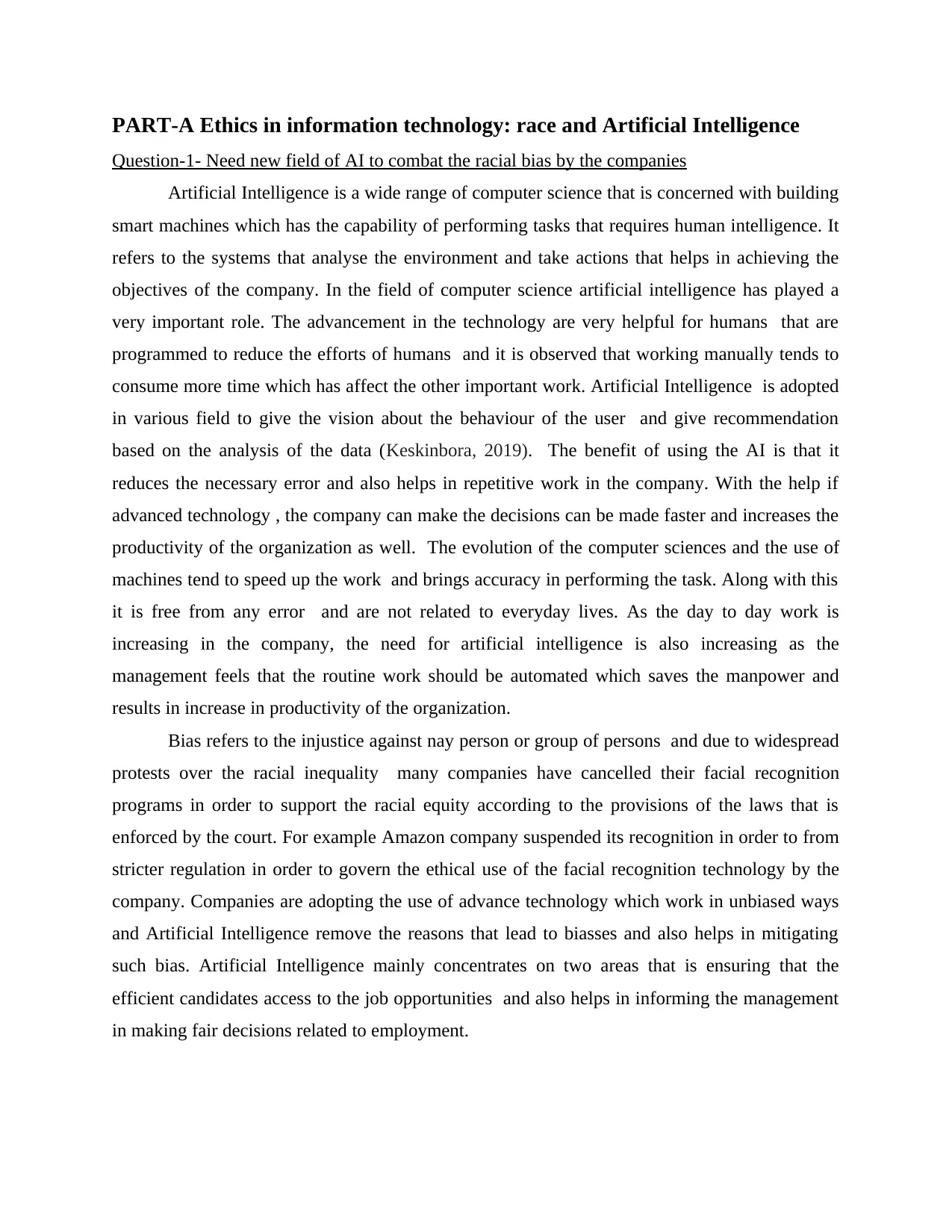
PART-A Ethics in information technology: race and Artificial Intelligence
Question-1- Need new field of AI to combat the racial bias by the companies
Artificial Intelligence is a wide range of computer science that is concerned with building
smart machines which has the capability of performing tasks that requires human intelligence. It
refers to the systems that analyse the environment and take actions that helps in achieving the
objectives of the company. In the field of computer science artificial intelligence has played a
very important role. The advancement in the technology are very helpful for humans that are
programmed to reduce the efforts of humans and it is observed that working manually tends to
consume more time which has affect the other important work. Artificial Intelligence is adopted
in various field to give the vision about the behaviour of the user and give recommendation
based on the analysis of the data (Keskinbora, 2019). The benefit of using the AI is that it
reduces the necessary error and also helps in repetitive work in the company. With the help if
advanced technology , the company can make the decisions can be made faster and increases the
productivity of the organization as well. The evolution of the computer sciences and the use of
machines tend to speed up the work and brings accuracy in performing the task. Along with this
it is free from any error and are not related to everyday lives. As the day to day work is
increasing in the company, the need for artificial intelligence is also increasing as the
management feels that the routine work should be automated which saves the manpower and
results in increase in productivity of the organization.
Bias refers to the injustice against nay person or group of persons and due to widespread
protests over the racial inequality many companies have cancelled their facial recognition
programs in order to support the racial equity according to the provisions of the laws that is
enforced by the court. For example Amazon company suspended its recognition in order to from
stricter regulation in order to govern the ethical use of the facial recognition technology by the
company. Companies are adopting the use of advance technology which work in unbiased ways
and Artificial Intelligence remove the reasons that lead to biasses and also helps in mitigating
such bias. Artificial Intelligence mainly concentrates on two areas that is ensuring that the
efficient candidates access to the job opportunities and also helps in informing the management
in making fair decisions related to employment.
Question-1- Need new field of AI to combat the racial bias by the companies
Artificial Intelligence is a wide range of computer science that is concerned with building
smart machines which has the capability of performing tasks that requires human intelligence. It
refers to the systems that analyse the environment and take actions that helps in achieving the
objectives of the company. In the field of computer science artificial intelligence has played a
very important role. The advancement in the technology are very helpful for humans that are
programmed to reduce the efforts of humans and it is observed that working manually tends to
consume more time which has affect the other important work. Artificial Intelligence is adopted
in various field to give the vision about the behaviour of the user and give recommendation
based on the analysis of the data (Keskinbora, 2019). The benefit of using the AI is that it
reduces the necessary error and also helps in repetitive work in the company. With the help if
advanced technology , the company can make the decisions can be made faster and increases the
productivity of the organization as well. The evolution of the computer sciences and the use of
machines tend to speed up the work and brings accuracy in performing the task. Along with this
it is free from any error and are not related to everyday lives. As the day to day work is
increasing in the company, the need for artificial intelligence is also increasing as the
management feels that the routine work should be automated which saves the manpower and
results in increase in productivity of the organization.
Bias refers to the injustice against nay person or group of persons and due to widespread
protests over the racial inequality many companies have cancelled their facial recognition
programs in order to support the racial equity according to the provisions of the laws that is
enforced by the court. For example Amazon company suspended its recognition in order to from
stricter regulation in order to govern the ethical use of the facial recognition technology by the
company. Companies are adopting the use of advance technology which work in unbiased ways
and Artificial Intelligence remove the reasons that lead to biasses and also helps in mitigating
such bias. Artificial Intelligence mainly concentrates on two areas that is ensuring that the
efficient candidates access to the job opportunities and also helps in informing the management
in making fair decisions related to employment.
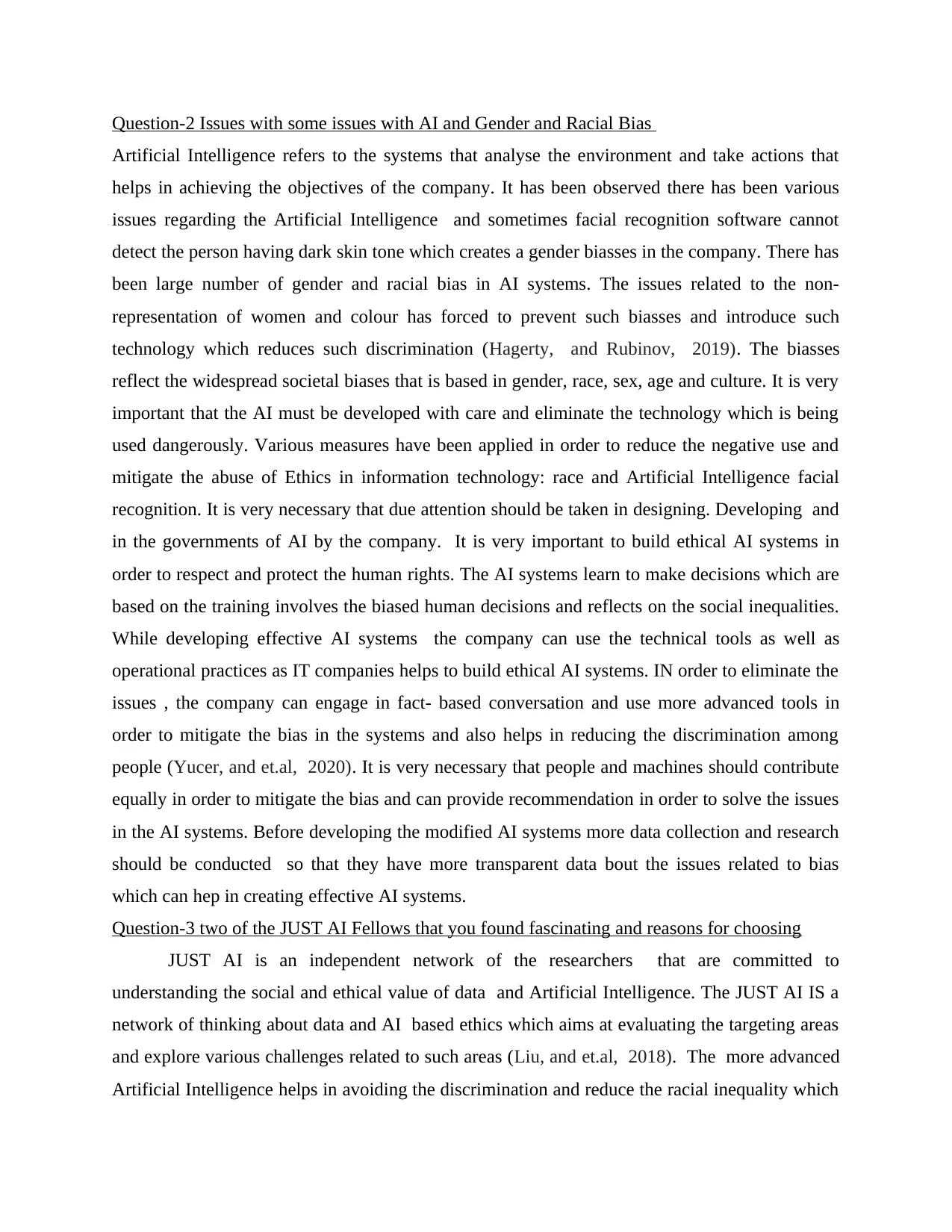
Question-2 Issues with some issues with AI and Gender and Racial Bias
Artificial Intelligence refers to the systems that analyse the environment and take actions that
helps in achieving the objectives of the company. It has been observed there has been various
issues regarding the Artificial Intelligence and sometimes facial recognition software cannot
detect the person having dark skin tone which creates a gender biasses in the company. There has
been large number of gender and racial bias in AI systems. The issues related to the non-
representation of women and colour has forced to prevent such biasses and introduce such
technology which reduces such discrimination (Hagerty, and Rubinov, 2019). The biasses
reflect the widespread societal biases that is based in gender, race, sex, age and culture. It is very
important that the AI must be developed with care and eliminate the technology which is being
used dangerously. Various measures have been applied in order to reduce the negative use and
mitigate the abuse of Ethics in information technology: race and Artificial Intelligence facial
recognition. It is very necessary that due attention should be taken in designing. Developing and
in the governments of AI by the company. It is very important to build ethical AI systems in
order to respect and protect the human rights. The AI systems learn to make decisions which are
based on the training involves the biased human decisions and reflects on the social inequalities.
While developing effective AI systems the company can use the technical tools as well as
operational practices as IT companies helps to build ethical AI systems. IN order to eliminate the
issues , the company can engage in fact- based conversation and use more advanced tools in
order to mitigate the bias in the systems and also helps in reducing the discrimination among
people (Yucer, and et.al, 2020). It is very necessary that people and machines should contribute
equally in order to mitigate the bias and can provide recommendation in order to solve the issues
in the AI systems. Before developing the modified AI systems more data collection and research
should be conducted so that they have more transparent data bout the issues related to bias
which can hep in creating effective AI systems.
Question-3 two of the JUST AI Fellows that you found fascinating and reasons for choosing
JUST AI is an independent network of the researchers that are committed to
understanding the social and ethical value of data and Artificial Intelligence. The JUST AI IS a
network of thinking about data and AI based ethics which aims at evaluating the targeting areas
and explore various challenges related to such areas (Liu, and et.al, 2018). The more advanced
Artificial Intelligence helps in avoiding the discrimination and reduce the racial inequality which
Artificial Intelligence refers to the systems that analyse the environment and take actions that
helps in achieving the objectives of the company. It has been observed there has been various
issues regarding the Artificial Intelligence and sometimes facial recognition software cannot
detect the person having dark skin tone which creates a gender biasses in the company. There has
been large number of gender and racial bias in AI systems. The issues related to the non-
representation of women and colour has forced to prevent such biasses and introduce such
technology which reduces such discrimination (Hagerty, and Rubinov, 2019). The biasses
reflect the widespread societal biases that is based in gender, race, sex, age and culture. It is very
important that the AI must be developed with care and eliminate the technology which is being
used dangerously. Various measures have been applied in order to reduce the negative use and
mitigate the abuse of Ethics in information technology: race and Artificial Intelligence facial
recognition. It is very necessary that due attention should be taken in designing. Developing and
in the governments of AI by the company. It is very important to build ethical AI systems in
order to respect and protect the human rights. The AI systems learn to make decisions which are
based on the training involves the biased human decisions and reflects on the social inequalities.
While developing effective AI systems the company can use the technical tools as well as
operational practices as IT companies helps to build ethical AI systems. IN order to eliminate the
issues , the company can engage in fact- based conversation and use more advanced tools in
order to mitigate the bias in the systems and also helps in reducing the discrimination among
people (Yucer, and et.al, 2020). It is very necessary that people and machines should contribute
equally in order to mitigate the bias and can provide recommendation in order to solve the issues
in the AI systems. Before developing the modified AI systems more data collection and research
should be conducted so that they have more transparent data bout the issues related to bias
which can hep in creating effective AI systems.
Question-3 two of the JUST AI Fellows that you found fascinating and reasons for choosing
JUST AI is an independent network of the researchers that are committed to
understanding the social and ethical value of data and Artificial Intelligence. The JUST AI IS a
network of thinking about data and AI based ethics which aims at evaluating the targeting areas
and explore various challenges related to such areas (Liu, and et.al, 2018). The more advanced
Artificial Intelligence helps in avoiding the discrimination and reduce the racial inequality which
Secure Best Marks with AI Grader
Need help grading? Try our AI Grader for instant feedback on your assignments.
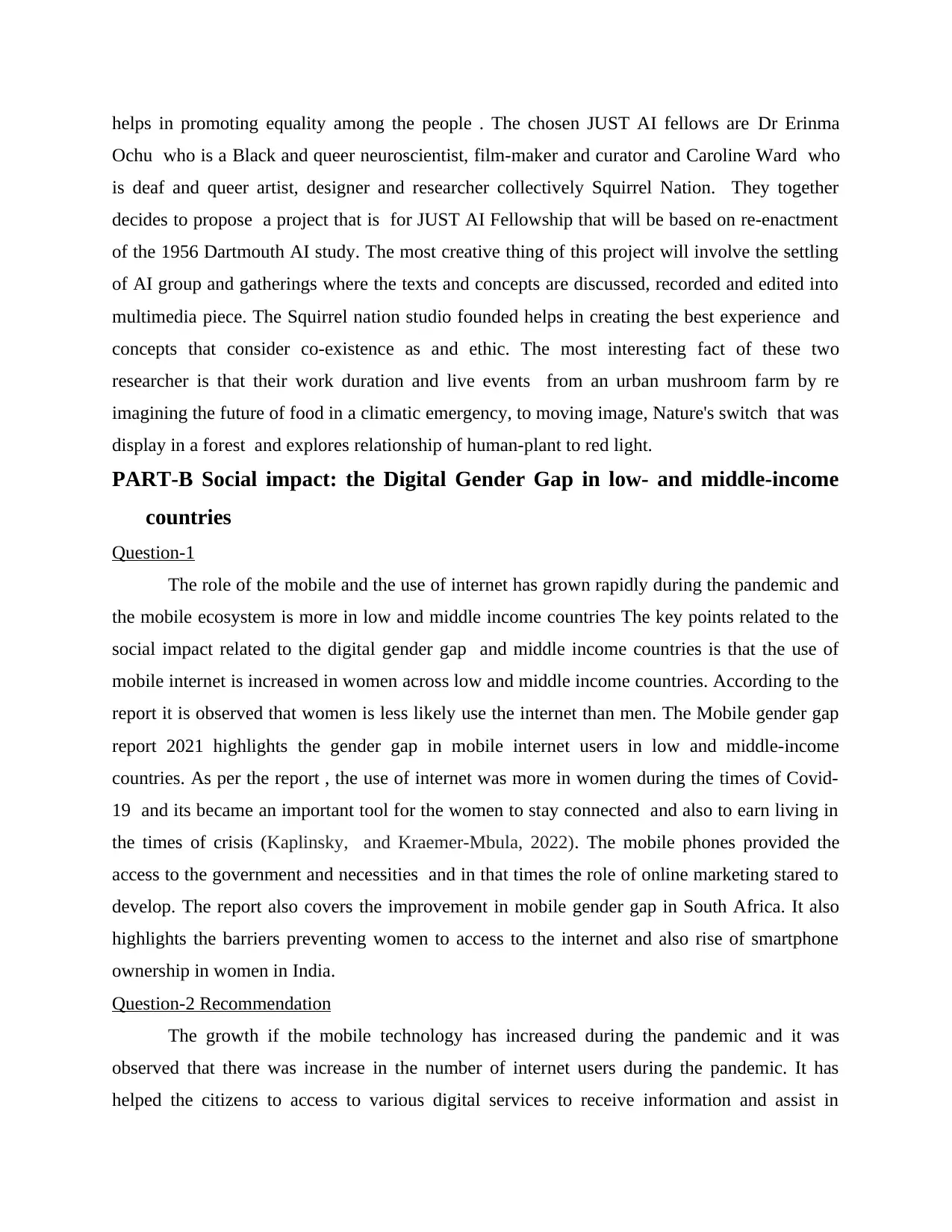
helps in promoting equality among the people . The chosen JUST AI fellows are Dr Erinma
Ochu who is a Black and queer neuroscientist, film-maker and curator and Caroline Ward who
is deaf and queer artist, designer and researcher collectively Squirrel Nation. They together
decides to propose a project that is for JUST AI Fellowship that will be based on re-enactment
of the 1956 Dartmouth AI study. The most creative thing of this project will involve the settling
of AI group and gatherings where the texts and concepts are discussed, recorded and edited into
multimedia piece. The Squirrel nation studio founded helps in creating the best experience and
concepts that consider co-existence as and ethic. The most interesting fact of these two
researcher is that their work duration and live events from an urban mushroom farm by re
imagining the future of food in a climatic emergency, to moving image, Nature's switch that was
display in a forest and explores relationship of human-plant to red light.
PART-B Social impact: the Digital Gender Gap in low- and middle-income
countries
Question-1
The role of the mobile and the use of internet has grown rapidly during the pandemic and
the mobile ecosystem is more in low and middle income countries The key points related to the
social impact related to the digital gender gap and middle income countries is that the use of
mobile internet is increased in women across low and middle income countries. According to the
report it is observed that women is less likely use the internet than men. The Mobile gender gap
report 2021 highlights the gender gap in mobile internet users in low and middle-income
countries. As per the report , the use of internet was more in women during the times of Covid-
19 and its became an important tool for the women to stay connected and also to earn living in
the times of crisis (Kaplinsky, and Kraemer-Mbula, 2022). The mobile phones provided the
access to the government and necessities and in that times the role of online marketing stared to
develop. The report also covers the improvement in mobile gender gap in South Africa. It also
highlights the barriers preventing women to access to the internet and also rise of smartphone
ownership in women in India.
Question-2 Recommendation
The growth if the mobile technology has increased during the pandemic and it was
observed that there was increase in the number of internet users during the pandemic. It has
helped the citizens to access to various digital services to receive information and assist in
Ochu who is a Black and queer neuroscientist, film-maker and curator and Caroline Ward who
is deaf and queer artist, designer and researcher collectively Squirrel Nation. They together
decides to propose a project that is for JUST AI Fellowship that will be based on re-enactment
of the 1956 Dartmouth AI study. The most creative thing of this project will involve the settling
of AI group and gatherings where the texts and concepts are discussed, recorded and edited into
multimedia piece. The Squirrel nation studio founded helps in creating the best experience and
concepts that consider co-existence as and ethic. The most interesting fact of these two
researcher is that their work duration and live events from an urban mushroom farm by re
imagining the future of food in a climatic emergency, to moving image, Nature's switch that was
display in a forest and explores relationship of human-plant to red light.
PART-B Social impact: the Digital Gender Gap in low- and middle-income
countries
Question-1
The role of the mobile and the use of internet has grown rapidly during the pandemic and
the mobile ecosystem is more in low and middle income countries The key points related to the
social impact related to the digital gender gap and middle income countries is that the use of
mobile internet is increased in women across low and middle income countries. According to the
report it is observed that women is less likely use the internet than men. The Mobile gender gap
report 2021 highlights the gender gap in mobile internet users in low and middle-income
countries. As per the report , the use of internet was more in women during the times of Covid-
19 and its became an important tool for the women to stay connected and also to earn living in
the times of crisis (Kaplinsky, and Kraemer-Mbula, 2022). The mobile phones provided the
access to the government and necessities and in that times the role of online marketing stared to
develop. The report also covers the improvement in mobile gender gap in South Africa. It also
highlights the barriers preventing women to access to the internet and also rise of smartphone
ownership in women in India.
Question-2 Recommendation
The growth if the mobile technology has increased during the pandemic and it was
observed that there was increase in the number of internet users during the pandemic. It has
helped the citizens to access to various digital services to receive information and assist in
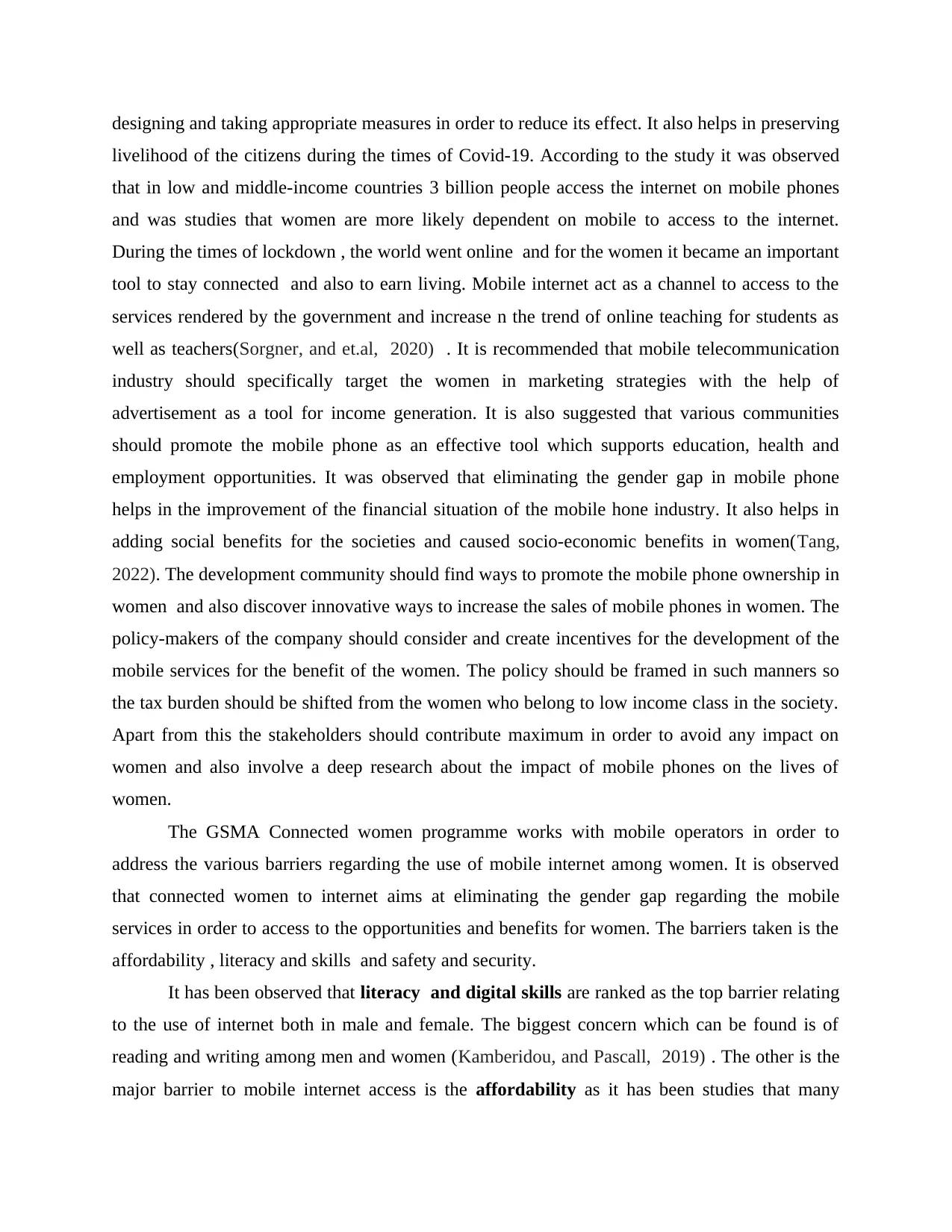
designing and taking appropriate measures in order to reduce its effect. It also helps in preserving
livelihood of the citizens during the times of Covid-19. According to the study it was observed
that in low and middle-income countries 3 billion people access the internet on mobile phones
and was studies that women are more likely dependent on mobile to access to the internet.
During the times of lockdown , the world went online and for the women it became an important
tool to stay connected and also to earn living. Mobile internet act as a channel to access to the
services rendered by the government and increase n the trend of online teaching for students as
well as teachers(Sorgner, and et.al, 2020) . It is recommended that mobile telecommunication
industry should specifically target the women in marketing strategies with the help of
advertisement as a tool for income generation. It is also suggested that various communities
should promote the mobile phone as an effective tool which supports education, health and
employment opportunities. It was observed that eliminating the gender gap in mobile phone
helps in the improvement of the financial situation of the mobile hone industry. It also helps in
adding social benefits for the societies and caused socio-economic benefits in women(Tang,
2022). The development community should find ways to promote the mobile phone ownership in
women and also discover innovative ways to increase the sales of mobile phones in women. The
policy-makers of the company should consider and create incentives for the development of the
mobile services for the benefit of the women. The policy should be framed in such manners so
the tax burden should be shifted from the women who belong to low income class in the society.
Apart from this the stakeholders should contribute maximum in order to avoid any impact on
women and also involve a deep research about the impact of mobile phones on the lives of
women.
The GSMA Connected women programme works with mobile operators in order to
address the various barriers regarding the use of mobile internet among women. It is observed
that connected women to internet aims at eliminating the gender gap regarding the mobile
services in order to access to the opportunities and benefits for women. The barriers taken is the
affordability , literacy and skills and safety and security.
It has been observed that literacy and digital skills are ranked as the top barrier relating
to the use of internet both in male and female. The biggest concern which can be found is of
reading and writing among men and women (Kamberidou, and Pascall, 2019) . The other is the
major barrier to mobile internet access is the affordability as it has been studies that many
livelihood of the citizens during the times of Covid-19. According to the study it was observed
that in low and middle-income countries 3 billion people access the internet on mobile phones
and was studies that women are more likely dependent on mobile to access to the internet.
During the times of lockdown , the world went online and for the women it became an important
tool to stay connected and also to earn living. Mobile internet act as a channel to access to the
services rendered by the government and increase n the trend of online teaching for students as
well as teachers(Sorgner, and et.al, 2020) . It is recommended that mobile telecommunication
industry should specifically target the women in marketing strategies with the help of
advertisement as a tool for income generation. It is also suggested that various communities
should promote the mobile phone as an effective tool which supports education, health and
employment opportunities. It was observed that eliminating the gender gap in mobile phone
helps in the improvement of the financial situation of the mobile hone industry. It also helps in
adding social benefits for the societies and caused socio-economic benefits in women(Tang,
2022). The development community should find ways to promote the mobile phone ownership in
women and also discover innovative ways to increase the sales of mobile phones in women. The
policy-makers of the company should consider and create incentives for the development of the
mobile services for the benefit of the women. The policy should be framed in such manners so
the tax burden should be shifted from the women who belong to low income class in the society.
Apart from this the stakeholders should contribute maximum in order to avoid any impact on
women and also involve a deep research about the impact of mobile phones on the lives of
women.
The GSMA Connected women programme works with mobile operators in order to
address the various barriers regarding the use of mobile internet among women. It is observed
that connected women to internet aims at eliminating the gender gap regarding the mobile
services in order to access to the opportunities and benefits for women. The barriers taken is the
affordability , literacy and skills and safety and security.
It has been observed that literacy and digital skills are ranked as the top barrier relating
to the use of internet both in male and female. The biggest concern which can be found is of
reading and writing among men and women (Kamberidou, and Pascall, 2019) . The other is the
major barrier to mobile internet access is the affordability as it has been studies that many
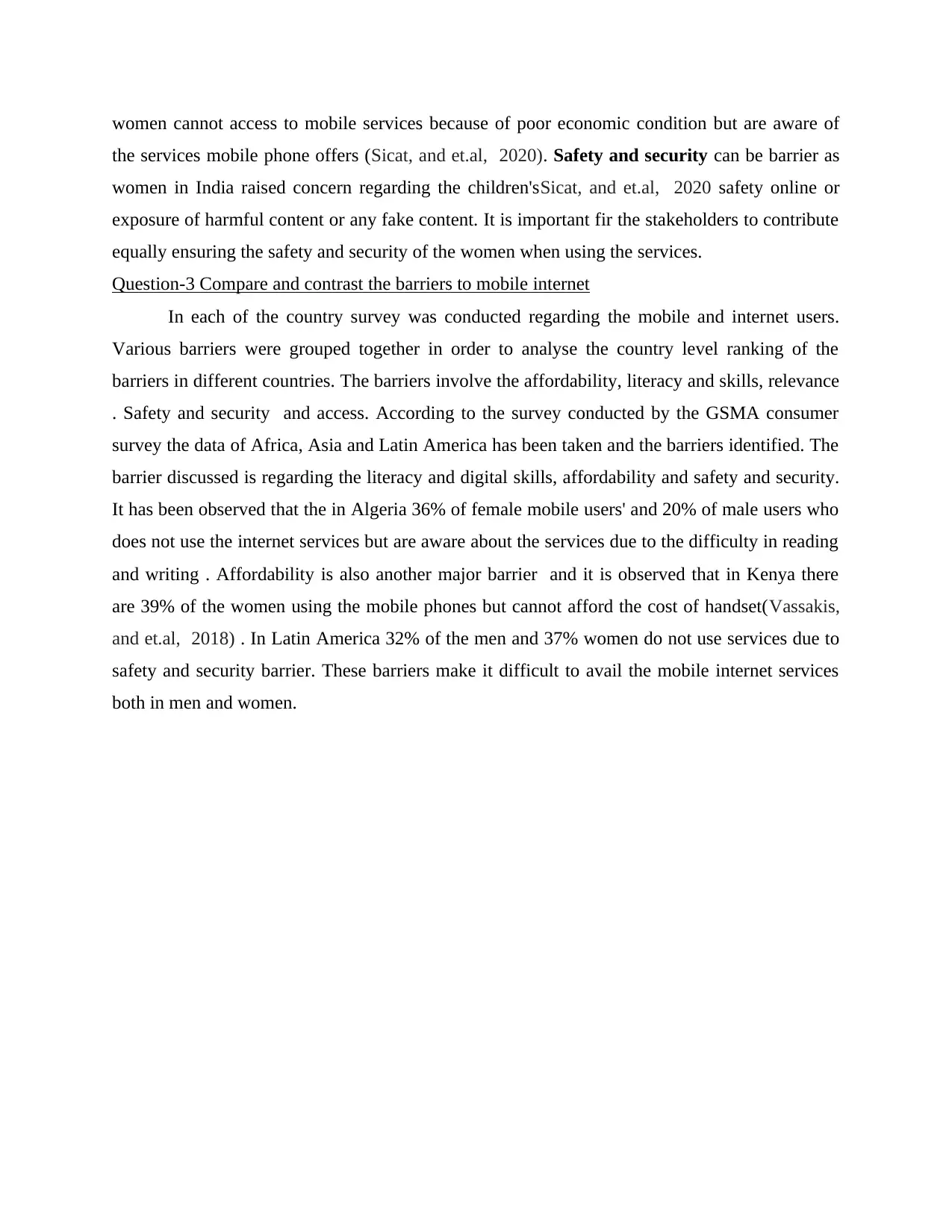
women cannot access to mobile services because of poor economic condition but are aware of
the services mobile phone offers (Sicat, and et.al, 2020). Safety and security can be barrier as
women in India raised concern regarding the children'sSicat, and et.al, 2020 safety online or
exposure of harmful content or any fake content. It is important fir the stakeholders to contribute
equally ensuring the safety and security of the women when using the services.
Question-3 Compare and contrast the barriers to mobile internet
In each of the country survey was conducted regarding the mobile and internet users.
Various barriers were grouped together in order to analyse the country level ranking of the
barriers in different countries. The barriers involve the affordability, literacy and skills, relevance
. Safety and security and access. According to the survey conducted by the GSMA consumer
survey the data of Africa, Asia and Latin America has been taken and the barriers identified. The
barrier discussed is regarding the literacy and digital skills, affordability and safety and security.
It has been observed that the in Algeria 36% of female mobile users' and 20% of male users who
does not use the internet services but are aware about the services due to the difficulty in reading
and writing . Affordability is also another major barrier and it is observed that in Kenya there
are 39% of the women using the mobile phones but cannot afford the cost of handset(Vassakis,
and et.al, 2018) . In Latin America 32% of the men and 37% women do not use services due to
safety and security barrier. These barriers make it difficult to avail the mobile internet services
both in men and women.
the services mobile phone offers (Sicat, and et.al, 2020). Safety and security can be barrier as
women in India raised concern regarding the children'sSicat, and et.al, 2020 safety online or
exposure of harmful content or any fake content. It is important fir the stakeholders to contribute
equally ensuring the safety and security of the women when using the services.
Question-3 Compare and contrast the barriers to mobile internet
In each of the country survey was conducted regarding the mobile and internet users.
Various barriers were grouped together in order to analyse the country level ranking of the
barriers in different countries. The barriers involve the affordability, literacy and skills, relevance
. Safety and security and access. According to the survey conducted by the GSMA consumer
survey the data of Africa, Asia and Latin America has been taken and the barriers identified. The
barrier discussed is regarding the literacy and digital skills, affordability and safety and security.
It has been observed that the in Algeria 36% of female mobile users' and 20% of male users who
does not use the internet services but are aware about the services due to the difficulty in reading
and writing . Affordability is also another major barrier and it is observed that in Kenya there
are 39% of the women using the mobile phones but cannot afford the cost of handset(Vassakis,
and et.al, 2018) . In Latin America 32% of the men and 37% women do not use services due to
safety and security barrier. These barriers make it difficult to avail the mobile internet services
both in men and women.
Paraphrase This Document
Need a fresh take? Get an instant paraphrase of this document with our AI Paraphraser
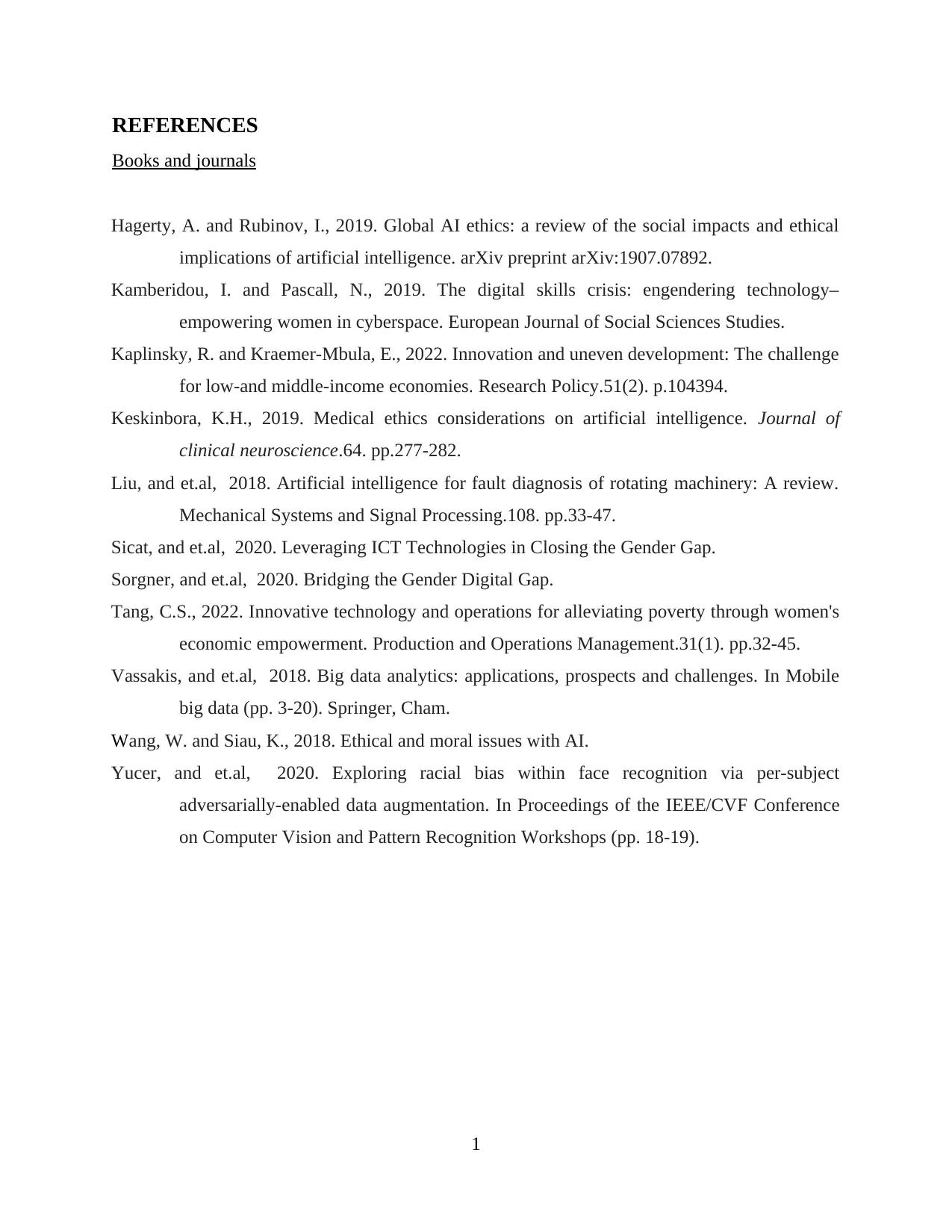
REFERENCES
Books and journals
Hagerty, A. and Rubinov, I., 2019. Global AI ethics: a review of the social impacts and ethical
implications of artificial intelligence. arXiv preprint arXiv:1907.07892.
Kamberidou, I. and Pascall, N., 2019. The digital skills crisis: engendering technology–
empowering women in cyberspace. European Journal of Social Sciences Studies.
Kaplinsky, R. and Kraemer-Mbula, E., 2022. Innovation and uneven development: The challenge
for low-and middle-income economies. Research Policy.51(2). p.104394.
Keskinbora, K.H., 2019. Medical ethics considerations on artificial intelligence. Journal of
clinical neuroscience.64. pp.277-282.
Liu, and et.al, 2018. Artificial intelligence for fault diagnosis of rotating machinery: A review.
Mechanical Systems and Signal Processing.108. pp.33-47.
Sicat, and et.al, 2020. Leveraging ICT Technologies in Closing the Gender Gap.
Sorgner, and et.al, 2020. Bridging the Gender Digital Gap.
Tang, C.S., 2022. Innovative technology and operations for alleviating poverty through women's
economic empowerment. Production and Operations Management.31(1). pp.32-45.
Vassakis, and et.al, 2018. Big data analytics: applications, prospects and challenges. In Mobile
big data (pp. 3-20). Springer, Cham.
Wang, W. and Siau, K., 2018. Ethical and moral issues with AI.
Yucer, and et.al, 2020. Exploring racial bias within face recognition via per-subject
adversarially-enabled data augmentation. In Proceedings of the IEEE/CVF Conference
on Computer Vision and Pattern Recognition Workshops (pp. 18-19).
1
Books and journals
Hagerty, A. and Rubinov, I., 2019. Global AI ethics: a review of the social impacts and ethical
implications of artificial intelligence. arXiv preprint arXiv:1907.07892.
Kamberidou, I. and Pascall, N., 2019. The digital skills crisis: engendering technology–
empowering women in cyberspace. European Journal of Social Sciences Studies.
Kaplinsky, R. and Kraemer-Mbula, E., 2022. Innovation and uneven development: The challenge
for low-and middle-income economies. Research Policy.51(2). p.104394.
Keskinbora, K.H., 2019. Medical ethics considerations on artificial intelligence. Journal of
clinical neuroscience.64. pp.277-282.
Liu, and et.al, 2018. Artificial intelligence for fault diagnosis of rotating machinery: A review.
Mechanical Systems and Signal Processing.108. pp.33-47.
Sicat, and et.al, 2020. Leveraging ICT Technologies in Closing the Gender Gap.
Sorgner, and et.al, 2020. Bridging the Gender Digital Gap.
Tang, C.S., 2022. Innovative technology and operations for alleviating poverty through women's
economic empowerment. Production and Operations Management.31(1). pp.32-45.
Vassakis, and et.al, 2018. Big data analytics: applications, prospects and challenges. In Mobile
big data (pp. 3-20). Springer, Cham.
Wang, W. and Siau, K., 2018. Ethical and moral issues with AI.
Yucer, and et.al, 2020. Exploring racial bias within face recognition via per-subject
adversarially-enabled data augmentation. In Proceedings of the IEEE/CVF Conference
on Computer Vision and Pattern Recognition Workshops (pp. 18-19).
1

2
1 out of 9
Related Documents
Your All-in-One AI-Powered Toolkit for Academic Success.
+13062052269
info@desklib.com
Available 24*7 on WhatsApp / Email
![[object Object]](/_next/static/media/star-bottom.7253800d.svg)
Unlock your academic potential
© 2024 | Zucol Services PVT LTD | All rights reserved.




